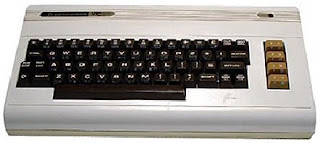
Is Vic there?
The Commodore VIC-20 was an 8-bit home computer which was sold by Commodore Business Machines (CBM). The VIC-20 was first announced around three years after Commodores first personal computer the PET in 1980.
Interestingly it became the first microcomputer to sell one million units - that's right, one million VIC-20's were sold. Commodore really hit the bulls-eye with this one. Many people did not even know why it was named 'The VIC' - it actually stood for Video Interface Chip.
Those sort of names really did sound cool back in the early 80's. Apparently the '20' part was conjured up as it was a 'friendly' number. The VIC was known as 'The Friendly Computer' mind.
Blessed with a whopping 5KB of RAM and a 6502A CPU running at approximately 1MHZ, the machine had around an average specification when compared to its competitors. The RAM was expandable, the machine could be upgraded to give an ample (at the time) 32KB to play with. It also had a co-processor under the hood (The VIC-I 6560) to help out when processing sound and graphics - which helped in the growing niche of computer games.
The sound chip, as in most Commodore machines was a decent one and was capable of producing three voices of sound over three octaves. This was pretty good for a home micro in 1981 and enhanced some of the earlier arcade games on Commodore machines.
It could generate very plain graphics and simple animations, but if you wanted detailed images and varying colours on your screen, you did not buy a VIC 20. Mind you, eight colours were available to use as character colours. The background and border area of the screen (many computers at thetime had the display setup this way), could be varied with up to 16 colours - similar to the classic games machine the ZX Spectrum.
It certainly had that 'Commodore look' to it, the off-white machine housing the darker brown keyboard, which became synonymous with Commodore 8-bit machines throughout the 1980's. Not a bad looker by any means.
With it being a popular machine, a good range of peripherals and software was available for it, including joysticks and the all important computer games (arcade games and text adventures). How in the name of Poseidon's Trident did they squeeze games with colour and sound into 5KB or RAM? A remarkable feat, whichever way you slice it. Some classic arcade games found their way onto the VIC 20.
Even good old Bill Shatner got in on the act, advertising the the machine and describing it as 'The wonder machine... of the 1980's!'. Good on ya Bill.
As the eighties rolled along, so did Commodore who became a major player in the 8-bit and 16-bit marketplace. The VIC 20 deserves a sideways glance at least. A decent retro computer.
We recommend trying to pick up one of these machines.
Look at computers for sale online or even locally.
If you don't want to get hold of the real hardware then try and download an emulator and
download those classic games. Alternatively you could try and play them online.
NAME: Commodore VIC 20
Interestingly it became the first microcomputer to sell one million units - that's right, one million VIC-20's were sold. Commodore really hit the bulls-eye with this one. Many people did not even know why it was named 'The VIC' - it actually stood for Video Interface Chip.
Those sort of names really did sound cool back in the early 80's. Apparently the '20' part was conjured up as it was a 'friendly' number. The VIC was known as 'The Friendly Computer' mind.
Blessed with a whopping 5KB of RAM and a 6502A CPU running at approximately 1MHZ, the machine had around an average specification when compared to its competitors. The RAM was expandable, the machine could be upgraded to give an ample (at the time) 32KB to play with. It also had a co-processor under the hood (The VIC-I 6560) to help out when processing sound and graphics - which helped in the growing niche of computer games.
The sound chip, as in most Commodore machines was a decent one and was capable of producing three voices of sound over three octaves. This was pretty good for a home micro in 1981 and enhanced some of the earlier arcade games on Commodore machines.
It could generate very plain graphics and simple animations, but if you wanted detailed images and varying colours on your screen, you did not buy a VIC 20. Mind you, eight colours were available to use as character colours. The background and border area of the screen (many computers at thetime had the display setup this way), could be varied with up to 16 colours - similar to the classic games machine the ZX Spectrum.
It certainly had that 'Commodore look' to it, the off-white machine housing the darker brown keyboard, which became synonymous with Commodore 8-bit machines throughout the 1980's. Not a bad looker by any means.
With it being a popular machine, a good range of peripherals and software was available for it, including joysticks and the all important computer games (arcade games and text adventures). How in the name of Poseidon's Trident did they squeeze games with colour and sound into 5KB or RAM? A remarkable feat, whichever way you slice it. Some classic arcade games found their way onto the VIC 20.
Even good old Bill Shatner got in on the act, advertising the the machine and describing it as 'The wonder machine... of the 1980's!'. Good on ya Bill.
As the eighties rolled along, so did Commodore who became a major player in the 8-bit and 16-bit marketplace. The VIC 20 deserves a sideways glance at least. A decent retro computer.
We recommend trying to pick up one of these machines.
Look at computers for sale online or even locally.
If you don't want to get hold of the real hardware then try and download an emulator and
download those classic games. Alternatively you could try and play them online.
NAME: Commodore VIC 20
MANUFACTURER: Commodore (CBM)
MACHINE TYPE: Home 8 bit micro (even some classic games!)
COUNTRY OF ORIGIN: United States (Gained reasonable popularity in the United Kingdom)
RELEASE YEAR: (1980 production) (May 1981 release)
END OF PRODUCTION: 1985
BUILT IN LANGUAGE(S): CBM Basic V2
KEYBOARD: QWERTY full stroke keyboard with 4 function keys, 66 keys overall
CPU: Commodore Semiconductor Group 6502A
SPEED: 1.0227 mHz
CO-PROCESSOR: VIC-I (6560) used for graphics and sound
RAM: 5KB (3583 bytes free) which was expandable up to 32 KB
VRAM: The screen memory was shared with the regular RAM
ROM: 16KB
TEXT MODES: 23 rows x 22 columns
GRAPHIC MODES: 184 x 176
COLORS: 8 character colors and 16 background or border colors
SOUND: 3 voices over 3 octaves.
SIZE / WEIGHT: 40.3 x 20.4 x 7.2 cm / 1,8 Kg
I/O PORTS: Pretty good. 1 joystick port, 1 user port, 1 cartridge port, 1 serial port, composite video output and a tape interface
POWER SUPPLY: External 18 Watt power supply unit
PRICE: ?
Retro Computers and classic games
PRICE: ?
Retro Computers and classic games




0 comments:
Post a Comment